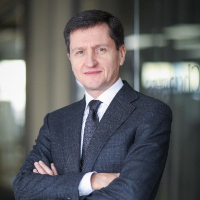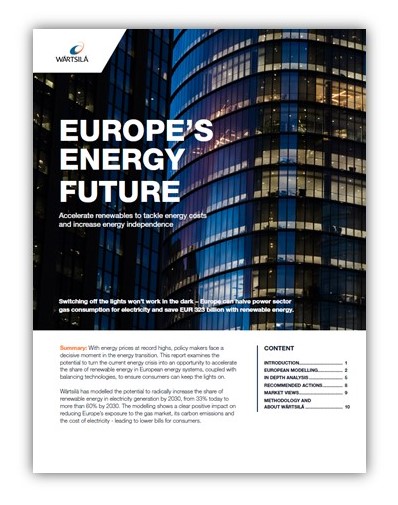

Securing Poland’s energy future
COST AND EMISSIONS REDUCED THROUGH CO-OPTIMISATION OF THE POWER SYSTEM AND DISTRICT HEATING
The energy landscape is undergoing a profound transformation, shifting towards renewable energy sources such as wind and solar to reduce emissions and enhance energy security.
Poland, much like other nations, is grappling with the challenge of lowering carbon emissions and transitioning to sustainable energy sources. For Poland’s coal dominated power system and district heating (DH) networks, this transition poses both challenges and immense opportunities.
Wärtsilä understands these challenges and is dedicated to finding sustainable solutions. We recognise the need to adapt existing systems for greater efficiency. By leveraging our expertise and cutting-edge solutions, we can support the transition to a low-carbon future and contribute to a cleaner and more sustainable Poland.
Our flexible solutions and expert guidance can help local authorities and district heating providers in Poland to enhance energy security and efficiencies while reducing emissions in a cost-optimal way. With flexible district heating technologies balancing intermittent renewables, the country can maximise its utilisation of cheap, zero-carbon energy.
Co-optimisation isn't just a buzzword – it's the key to unlocking unparalleled efficiency. Harmonising Poland’s power system and heat generation in this way reduces both costs and emissions, laying the foundation for a 100% renewable-energy future while advancing energy security and affordability.

Swift, decisive action is needed to secure Poland's energy transition.
Powering Poland’s Future: Optimising the power system and district heating for the next decade
The transition from coal-dominated to majority renewable electricity and heating systems represents a profound transformation. Yet, this study demonstrates how Poland can achieve this over the next decade — while unlocking substantial system cost savings and emissions reductions across both sectors.
To get started, please contact:

Igor Petryk, Market Development Director, Wärtsilä Energy
Email: igor.petryk@wartsila.com
Contact: +358 10 7095676

Sergey Zoubarev, Business Development Manager, Wärtsilä Energy
Email: sergey.zoubarev@wartsila.com
Contact: +358 10 7094525
Gain more insights
Press Release
Poland news
Replacing coal with renewable generation and flexibility promises European energy independence, Wärtsilä finds
Modelling by the technology group Wärtsilä has revealed that major system-wide benefits are in reach for European power producers that rapidly replace coal with renewable generation & flexibility: from avoiding fuel & carbon costs - to new clean power export opportunities.
Energy system modelling of Germany and Ukraine - two key European countries with vastly different power systems and policies to phase-out coal - shows that the coal capacity gap can be met cost optimally with renewable electricity coupled with flexible resources, i.e. flexible thermal power plants and energy storage.
“Our analysis from both sides of the coal exit spectrum is clear: value has been eroded from coal by low-cost renewable baseload. The coal phase-out presents myriad opportunities for European countries to cut production costs, achieve energy independence and create revenue through society-wide sector coupling. Flexibility is key to “levelling up” variable renewables to fulfil a baseload role to realise these benefits,” said Jan Andersson, Market Development Manager for Europe, Wärtsilä Energy.
Wärtsilä modelled a “Fast Phase-out 2030” scenario in which Germany eliminate coal-fired power by 2030 (eight years ahead of target) highlighting that the value of coal-fired power would be eroded by building 13 GW of new renewable capacity annually. Key insights for Germany include:
- Additional renewable baseload makes Germany less dependent on imports from neighbouring countries during the coal-phase out years, shifting from a net importer to net exporter in the 2030s.
- Germany could save up to 600m tonnes of CO2 by 2045, equivalent to 81% of its national carbon footprint today (compared to phasing out coal by 2038).
- To meet heating demand as coal is phased-out, plus to balance the influx of new renewables, up to 12 GW of flexible gas-powered Combined Heat & Power (CHP) is required.
“In Germany, decisions taken in the next few months will determine whether they ramp up power imports (racking up cost and carbon) from neighbouring countries to fill the capacity gap, or pave the way to becoming a net exporter of clean power to the rest of Europe,” Jan Andersson added.
Wärtsilä modelled the outcome of a key decision Ukraine must make in coming months: whether to modernise or retire its coal - to meet its national emission reduction targets. Key insights for Ukraine include:
- The power system relying on modernised coal is EUR 5.2 billion (10%) more expensive for consumers over 10 years, mainly due to the cost of domestically produced and imported coal to run its fleet of power stations.
- Modernising Ukraine’s coal power stations will emit 53 million tonnes (32%) more CO2 than retiring and replacing coal with a mix of low carbon technologies between 2022 and 2031.
- A new cost optimal system, based on 32 GW of new renewables and flexibility, would save EUR 500 million annually on the cost of generated electricity by 2031.
“Unlike Germany, Ukraine is not currently able to incentivise its coal exit, so it is vital that they find the lowest cost path to cleanly meeting power demand. Our modelling gives a clear outcome: modernisation of coal is far more costly than retirement and leaves the system more exposed to climate risk, whereas investments into renewables, plus battery energy storage and gas balancing, lead to system-level cost savings,” added Igor Petryk, Market Development Director, Wärtsilä Energy.
About the modelling
The Germany and Ukraine models were completed by inputting power system data and scenario definitions into the PLEXOS System Optimiser platform. The platform is focused on finding the cost optimal energy mix by finding the lowest cost solutions for defined scenarios. In the optimisation process all defined real-life constraints are considered, as well as hourly dispatch and capacity additions.
Learn more:
Webinar recording: Value of flexibility is recognised in Germany
White paper: Flexibility to future-proof the Ukrainian power system
Article: How advanced modelling is helping Ukraine go green
Article: Sector coupling key to the future of Germany’s clean energy transformation
Media contact for more information on this release:
Mirja-Maija Santala
Manager, Marketing & Communications
Wärtsilä Energy
Mob: +358 400 793 827
mirja-maija.santala@wartsila.com
Image: Wärtsilä’s power system modelling by using PLEXOS reveal major system-wide benefits for European power producers that rapidly replace coal with renewable generation & flexibility © Wärtsilä Corporation
All Wärtsilä releases are available at https://www.wartsila.com/media/news-releases and at http://news.cision.com/wartsila-corporation where also the images can be downloaded.
Wärtsilä Energy in brief
Wärtsilä Energy leads the transition towards a 100% renewable energy future. We help our customers in decarbonisation by developing market-leading technologies. These cover future-fuel enabled balancing power plants, hybrid solutions, energy storage and optimisation technology, including the GEMS energy management platform. Wärtsilä Energy’s lifecycle services are designed to increase efficiency, promote reliability and guarantee operational performance. Our track record comprises 74 GW of power plant capacity and more than 80 energy storage systems delivered to 180 countries around the world.
https://www.wartsila.com/energy
Wärtsilä in brief
Wärtsilä is a global leader in smart technologies and complete lifecycle solutions for the marine and energy markets. By emphasising sustainable innovation, total efficiency and data analytics, Wärtsilä maximises the environmental and economic performance of the vessels and power plants of its customers. In 2020, Wärtsilä's net sales totalled EUR 4.6 billion with approximately 18,000 employees. The company has operations in over 200 locations in more than 70 countries around the world. Wärtsilä is listed on Nasdaq Helsinki
www.wartsila.com



